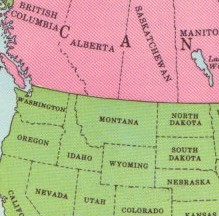Washington (U.S. state): Difference between revisions
imported>John Stephenson m (Washington moved to Washington (state): Needs disambiguation from D.C., George, that place in the UK...) |
(Physiography) |
||
| Line 4: | Line 4: | ||
The capital is Olympia. Most of the people live in the metropolitan areas of [[Seattle]] and [[Tacoma]] and other cities along [[Puget Sound.]] The [[University of Washington]] in Seattle was established in 1861. | The capital is Olympia. Most of the people live in the metropolitan areas of [[Seattle]] and [[Tacoma]] and other cities along [[Puget Sound.]] The [[University of Washington]] in Seattle was established in 1861. | ||
==Physiography== | |||
The state of Washington is divided by the [[Cascade Mountains]] into an eastern and a western portion. The [[Olympic Mountains]] lie on a peninsula to the west with the [[Strait of Juan de Fuca]] and [[Puget Sound]] extending inland from the [[Pacific Ocean]] between these two major mountain ranges. | |||
The state has several distinct geographic regions, including the Olympic Mountains which feature a rain forest with up to 150 inches of precipitation per year on its western slopes. The Puget Sound lowlands extend from Canada to Oregon and feature excellent harbors. To the east lies the Cascade Mountains which feature several stratovolcanoes including [[Mount Rainier]] and [[Mount St. Helens]] which erupted most recently in 1981. The Columbia Plateau in the eastern portion of the state is a large basalt plain scarred by numerous coulees and featuring fertile, volcanic soil. | |||
Rivers to the east of the Cascades drain into the [[Columbia River]] and its tributaries, ultimately emptying into the Pacific Ocean. To the west of the Cascades, rivers drain either directly into the Pacific or into Puget Sound. | |||
Revision as of 10:38, 9 November 2022
Washington is one of the states of United States of America; it was admitted to the Union as the 42nd state on November 11, 1889. It lies at the northwest corner of the contiguous part of the US, in the Pacific Northwest region. Washington is bounded by the Canadian province of British Columbia on the north, Idaho on the east, Oregon on the south, and the Pacific Ocean on the west. The state has an area of 68,139 square miles (176,479 square kilometers) and an estimated population of 6,549,224 (2008).
The capital is Olympia. Most of the people live in the metropolitan areas of Seattle and Tacoma and other cities along Puget Sound. The University of Washington in Seattle was established in 1861.
Physiography
The state of Washington is divided by the Cascade Mountains into an eastern and a western portion. The Olympic Mountains lie on a peninsula to the west with the Strait of Juan de Fuca and Puget Sound extending inland from the Pacific Ocean between these two major mountain ranges.
The state has several distinct geographic regions, including the Olympic Mountains which feature a rain forest with up to 150 inches of precipitation per year on its western slopes. The Puget Sound lowlands extend from Canada to Oregon and feature excellent harbors. To the east lies the Cascade Mountains which feature several stratovolcanoes including Mount Rainier and Mount St. Helens which erupted most recently in 1981. The Columbia Plateau in the eastern portion of the state is a large basalt plain scarred by numerous coulees and featuring fertile, volcanic soil.
Rivers to the east of the Cascades drain into the Columbia River and its tributaries, ultimately emptying into the Pacific Ocean. To the west of the Cascades, rivers drain either directly into the Pacific or into Puget Sound.
